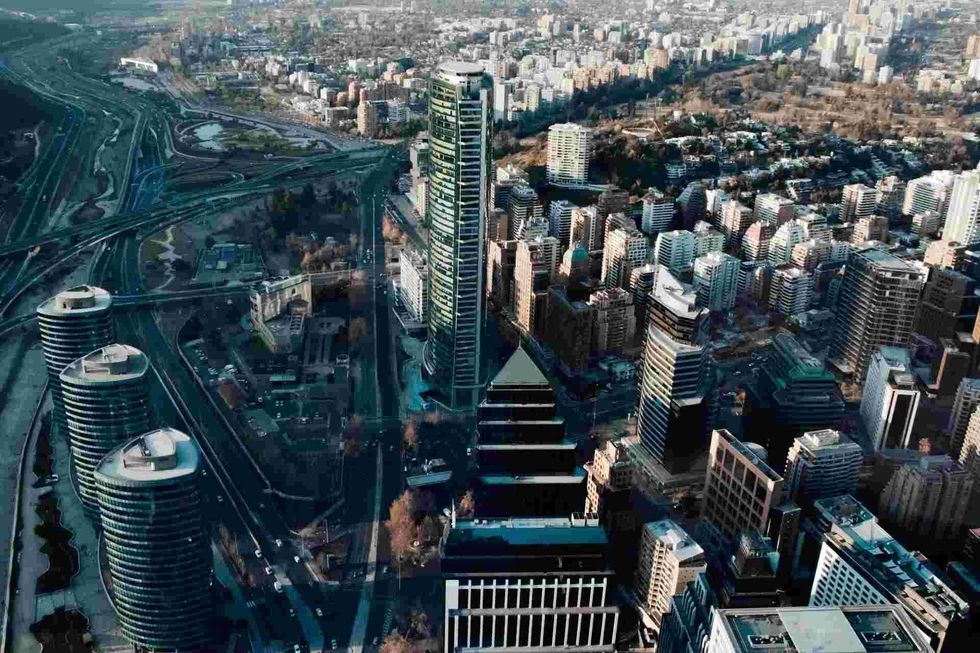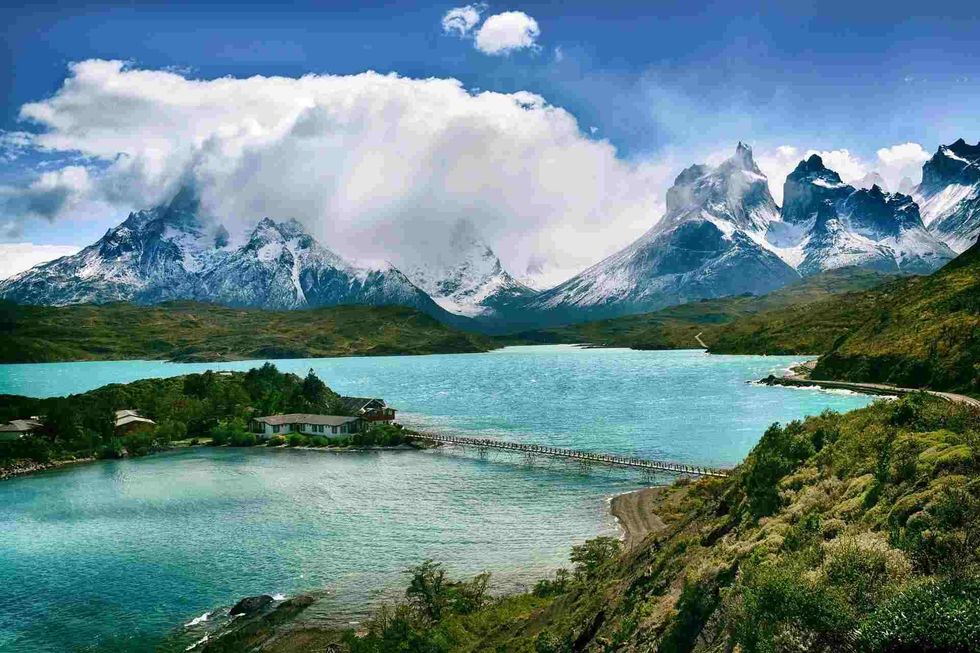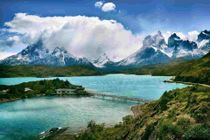107 Facts About Chile, South America: This Will Make You Plan Your Next Trip

Chile as a nation has astounding biodiversity, ranging from desert shorelines to volcanoes, and glaciers in an area only slightly bigger than Montana.
The country's boundaries are covered with a stretch of 3728 mi (5999.6 km) of the pacific ocean coastline. The currency of Chile is called the Chilean peso.
Chile is situated in the west part of South America. It is located west of the pacific ocean and east of the Andes Mountains. It captures a narrow and long land. The Atacama Desert is on the north coast. As per the survey of 2017, Chile has a population of about 17.5 million.
It is at the southern tip of the world, and it is close to the border of Peru and Antarctica. Chile is rich in some mineral resources such as lithium and cover.
And it is used for electric vehicles to strengthen the economy as well as to promote renewable resources. There are frequent religious festivals and events, dances, and traditions in Chile.
People of Chile South America
In Chile, the people are initially a combination of the Indigenous people, Europeans and other settlers.
- Chile has a population of 17 million people. The population is well educated, and since the '70s, there has been a steady decrease in poverty at an annual rate of 0.5%.
- Chile's economy is among the best run in South America. The average salary is US$ 7300, which makes it easy to live here on one income and to save money. It's also ranked as the 4th most popular country in the world to do business with.
- The economy is stable here because of the diligent culture, and the region is rich in resources - both land and sea.
- The majority of people in Chile are Roman Catholic, and the rest are Christian protestants.
- Nearly 60% of people are Romans, and 15% are Christians. About 25% of people are non-affiliated.
- Mapuche people primarily occupy Southern Chile. Other regions in Southern Chile are pretty cautious about recognizing and resecting this indigenous group for their customs and history.
- The people of Chile have a great liking for sea food. The cuisine of Chile is mainly seafood that includes salmon, sea bass, oysters, and many more.
Plant And Animal Life In Chile
Chile has a wealth of plant and animal life, including diverse fauna (animals) and flora. Mammals, birds, and reptiles represent the fauna.
- The diverse plant life in Chile includes 2% of all tree species on Earth. The country has around 2000 vascular plants and another 300 sub-vascular species.
- Among these are the Gomero (deciduous tree), the "Araucaria araucana" (a native evergreen tree), and many others. Chile's national flower is called "Torch Lily" and is a gift from its neighbor - Argentina.
- Chile has a range of agricultural products: apple, grapes, oats, peaches, hemp, and many more.
- Due to different geological locations, Chile has many ecosystems such as mountains, glaciers, deserts, and forests.
- Chile has established many wildlife reserves and national parks for animals. One of the national parks is Torres del Paine, located in Patagonia, Chile.
- It has a variety of animals such as deer, foxes, rheas, and many birds like flamingos, eagles, and owls. Also, there are some endangered animals species such as Chinchilla, Andean Mountain cat, marine otter, and Andean Condor.
- The nation's vegetation varies according to climate, altitude, latitude, the interaction between humans and each region's native flora, and so on.
- Soil fertility is high in Chile, making for good agricultural land. Typical crops include wheat, corn sorghum, grapes that are used to make wine, as well as peaches which are exported extensively.
- Chile also has marine biodiversity known for having many endemic species, such as the Patagonian toothfish found only in this region and the "Chilean sea lion" (a species of sea lion).
- Chile's desert regions have cacti species found in both deserts in North America, such as the Joshua tree or palo verde. Similar to North America, some desert eagles (the same type of bird) are also found here.
- Chile is home to a condor similar to its American counterpart, except that it has a wingspan of up to nine feet.
- The Andes Mountains are home to the puma, and there are two types of fox - one with a thick coat and the other with red fur running down its back.
Languages in Chile South America
The official language of Chile is Spanish due to migrants from all around the world.
- Nearly 10% of people are indigenous in Chile, and the rest are Mapuche ethnicities. About 99.3% of the population in Chile speak Chilean Spanish.
- Chile has received the title of Castellano for Spanish. At least 15 different languages are used in Central Chile.
- The Mapuche and Quechua languages are indigenous and spoken by 70,000 and eight million people.
- While Spanish is the official language, English is commonly taught in schools from a young age as it is one of Chile's major economic partners.

Chile South America: Attractions
By being the safest country in South America, Chile also offers several attractions for which it is known worldwide.
- The capital city's attractions include the Plaza de Armas, where you'll find the national cathedral and several historical buildings.
- The country is blessed with many mountains and deserts, and they have great national parks as well. Attractions in mainland Chile and specific locations like moon valley add to the beauty.
- Torres del Paine national park in Chile's most important natural area and is also a popular travel destination.
- The second attraction from Chile is the Vale de la Luna and the Atacama desert. In northern Chile, it lies 8 mi (12.8 km) west of the San Pedro de Atacama. Here it is accessed with the well-marked bike and tour buses.
- Rapa Nui national park is famous for its most prominent attributes: the archeological sites. It is also estimated that there are 900 statues and more than 300 ceremonial platforms.
- This Latin American Country has 99.97 % of the total population residing in the continental Chile area.
- Last but not least is the Chilean lake district. It also comes in the list of the best attractions of Latin America. It is located in the center of Chile.
Chile South America: World Records
Yes, apart from being one of the most beautiful countries, Chile also has some world records in its name.
- Cerro Paranal Observatory is considered the world's leading observatory regarding its astronomical equipment. It is also the place that offers some of the clearest views in Chile.
- The National Park of Los Flamencos is the world's largest maritime reserve, and it includes the islands of the Chiloé Archipelago and Hualfín Peninsula in the Pacific Ocean.
- The Puconia Pygmy Nene Project in this nation is a place where some of the world's rarest birds thrive. The project was started in 1977, and it is still active.
- The list includes the fastest time for trek for the south pole unsupported team, having the highest astronomical observatory, the largest bunch of the grapes, the largest swimming pool, the largest virus identified, the most durable polo player, the smallest desert, and the tree with the most different fruit.
Did you know?
Chile has the world’s biggest swimming pool. It takes five years to build and costs nearly about $1 billion, and the annual maintenance cost is $2 million. Here are more such facts about Chile you should know.
- The Guinness Book of records is also named the artificial paradise for the world’s largest swimming pool. The length is 3 ft (0.91 m), where its area is 0.031 sq mi (0.08 sq km), and it also has a depth of 115 ft (35 m). It can hold over 66,000,000 gals (300,041,940 L) of clear crystal seawater.
- Chile is the only country in the whole world where it has water privatization enacted throughout the country.
- Did you know that Chile has the driest place on the earth, known as the Atacama desert? This region never receives rainfall, and it is the oldest desert on earth.
- One of the Chinchorro mummies was found in the Camarones Valley in Chile around 500 BC.
- The driest place called the Atacama desert attracts many tourists to the country.
- Leaving behind the country's scenic beauty, Chile has to offer a lot more things.
- There are many adventures like hiking, trailing, sandboarding, heli-skiing, surfing, white water rafting, and so on you can try in the southern hemisphere.
- Also, the Republic of Chile officially, by the metrics, has ranked 42nd out of the 189 countries, and that’s why it’s also known as the first world nation by the ranking of their HDI.
- Like Santiago, the Capital City, there are more places like Patagonia and Atacama desert.
- Chile is also known as the sleeper country and most probably is famous for Nobel prize-winning poets.
- The population of Chile is known for being the 62nd most populous country.
- By the estimate of the year 2019, the population is 18.95 million of the Chilean population. It means that for every square kilometer of land, there are 24 people.
- The main reason is the beauty of this country, the glaciers and the mountains, volcanoes and the lakes.
- Central Chile is in a central position between two mountain ranges: the Andes mountains and coastal mountains. Its territory is narrow, but it is the longest country in South America.
- The Andes mountains are the tallest in the world.
- Chile is also considered the safest country in South America. With being the safest country, it also has a stable economy. Easter Island is located on the off coast of Chile.
- In 2007, Chile’s contribution towards the economy was 4.9%, and it can employ the country's labor at about 13.6%.
- Chile is the richest country in South America, with a high standard of living and a well-developed economy South America.
- In Chile, things like mining, manufacturing, personal services, and retail trade have bolstered the economy and also made the country the leading contender for wealth on the whole world circuit.
- The poverty in Chile was a low percentage which is 14.4%. But the problem that comes in this country is the high rates of income inequality.
- The Chilean flag is made up of two equally-sized rectangles, one red and one blue. The blue rectangle is on top, with the red rectangle underneath.
- On the left side of the Chilean flag, there is a white square outlined in black that includes a large star with five-pointed points on each point and four smaller stars pointing out from it towards the corners.
- Chilean navy is quite famous for their training ship work - especially the Esmeralda. Esmeralda is the world record holder for maximum average speed for its type.
- The recent news states that the navy rescued 120 people from a grounded cruise ship.
- The tallest building in Chile rises 70 stories above the ground and is 874 ft (266.3 m) tall. This tallest building is several miles away from the Gulf of Penas on Chile's southern border.
- Among the typical dishes of this place are Empleadas, pastel de Choclo, Curanto, and Cazuela de Mariscos.
- The empanadas are thin blue corn tortillas stuffed with cheese or meat and vegetables.
- Pastel de Choclo is a beef, rice, and corn casserole dish served with a special bread on top made of the same ingredients. Many Chileans enjoy eating meat casserole served with shellfish, potatoes, and vegetables.
- The traditional Chilean Cazuela is a seafood and vegetable stew that includes clams, prawns, fish, and mussels. Examples of national drink items here are 'pisco sour' and 'pinot noir.' They're both made from grapes.
- A pisco sour contains pisco brandy, fresh lemon juice, egg white, and sugar syrup. The pinot noir is made from pinot grapes grown in Chilean vineyards.
- Chile's national dance is commonly known as the cueca. It was influenced by Spaniards and featured fast and slow rhythms and unique movement patterns created for the dance.
- The cueca is prevalent in many regions of South America, including Peru, Bolivia, and Argentina. Many tourists visit Chile to learn to dance this lively dance during special events.
- Chile is known for its narrow country, forming a land bridge across the Andes Mountains. Because Chile is so narrow and the mountains are so tall, people who live on the coasts of Chile can't be reached by land without going over a mountain range.
- One of them is called Mapudungun, which originated in central and southern Chile. Its speakers are called Mapuches, and they live in those regions of Chile.
- Chileans love their national flower. The hollyhock is known as the 'Flores de la Virgen' (Flowers of the Virgin). This tall, red flower is in honor of the patron saint of Chile, Our Lady of Copacabana.
- The Virgin of Copacabana is a statue that an archaeologist made in the 16th century.
- The statue is located in Santiago de Chile, located in the south of the country. Its indigenous culture and Spanish influence have influenced Chile's national identity.
- Chileans are proud of their heritage because it is a part of their people. Many Chileans continue to speak Mapudungun, so it is still a big part of their cultural heritage.
- The Uyghurs were Andean people who emigrated to coastal southern Chile and Argentina during the early years of the twelfth century A.D.
- Active volcanoes are Chile's most famous natural feature. These include the Andes Mountains and the coastal mountains.
- The central valley is at a central position between the Andes mountain ranges on the west and the coastal mountain ranges on the east, contributing to the list of attractions apart from the active volcanoes.
- A democratic system of government governs the Chilean government. There is an election every four years to choose the president and members of Congress.
- The coastal valley is at a central position between the Andes mountain ranges on the west and the coastal mountain ranges on the east.
- Chilean parakeet is the national bird of Chile, which has nine subspecies.
- The last but not the least amazing fact is that the world’s most powerful earthquake has also happened in this country Chile.
The country's resources are varied and significant to this day- copper, silver, nitrates, coal oil shale, gold, and more. That contributes to why one-third of all foreign investment in South America goes into this country.
Chile's climate ranges from extremely arid to temperate depending on where in the country you are at. The northern desert areas and southern Patagonian glaciers have opposite climates. However, it is possible to experience all four major types of climate found on Earth - rainforest, Mediterranean, Atacama desert, and tundra.
We Want Your Photos!
More for You
Bachelor of Science specializing in Computer Science

Christian MbaBachelor of Science specializing in Computer Science
Christian Mba is an experienced blogger and content writer with over a decade of experience. He holds a Bachelor of Science degree in Computer Science from Nigeria and has a keen interest in Python programming. Along with his writing and blogging expertise, he is also an SEO specialist with more than six years of experience. Chris, as he is commonly known, has a passion for music and enjoys playing the piano.
Disclaimer
1) Kidadl is independent and to make our service free to you the reader we are supported by advertising. We hope you love our recommendations for products and services! What we suggest is selected independently by the Kidadl team. If you purchase using the Buy Now button we may earn a small commission. This does not influence our choices. Prices are correct and items are available at the time the article was published but we cannot guarantee that on the time of reading. Please note that Kidadl is a participant in the Amazon Services LLC Associates Program, an affiliate advertising program designed to provide a means for sites to earn advertising fees by advertising and linking to Amazon. We also link to other websites, but are not responsible for their content.
2) At Kidadl, we strive to recommend the very best activities and events. We will always aim to give you accurate information at the date of publication - however, information does change, so it’s important you do your own research, double-check and make the decision that is right for your family. We recognise that not all activities and ideas are appropriate for all children and families or in all circumstances. Our recommended activities are based on age but these are a guide. We recommend that these ideas are used as inspiration, that ideas are undertaken with appropriate adult supervision, and that each adult uses their own discretion and knowledge of their children to consider the safety and suitability. Kidadl cannot accept liability for the execution of these ideas, and parental supervision is advised at all times, as safety is paramount. Anyone using the information provided by Kidadl does so at their own risk and we can not accept liability if things go wrong.
3) Because we are an educational resource, we have quotes and facts about a range of historical and modern figures. We do not endorse the actions of or rhetoric of all the people included in these collections, but we think they are important for growing minds to learn about under the guidance of parents or guardians.







